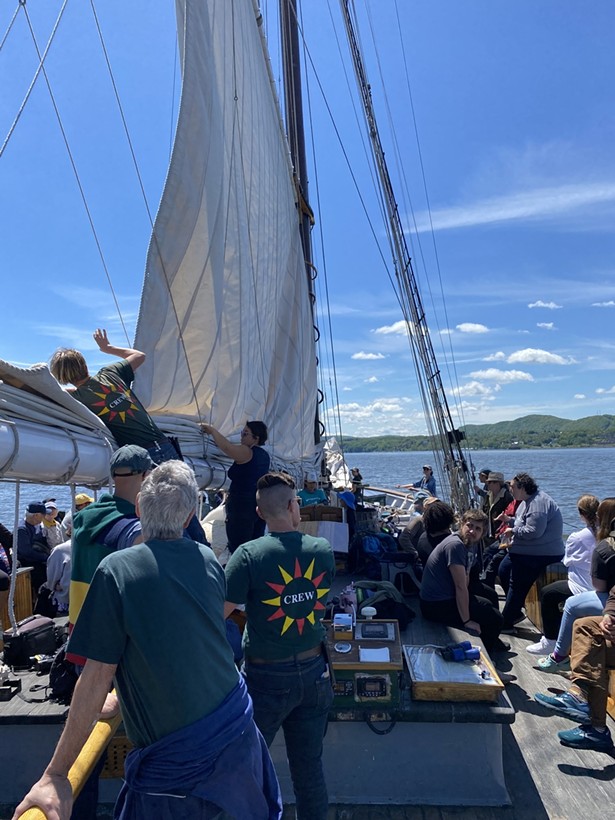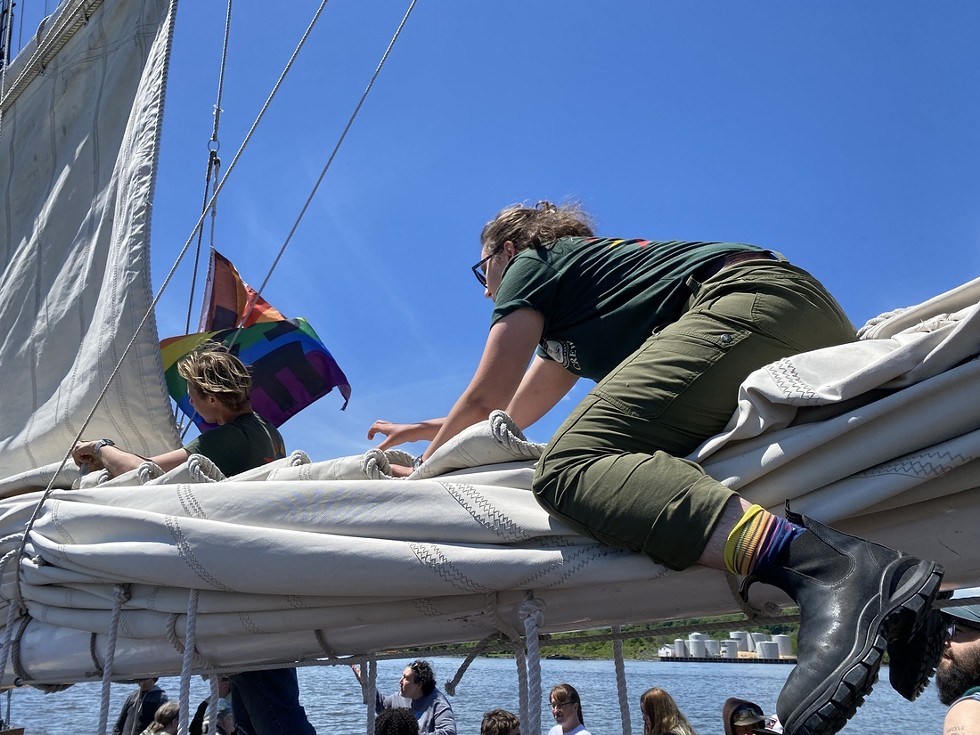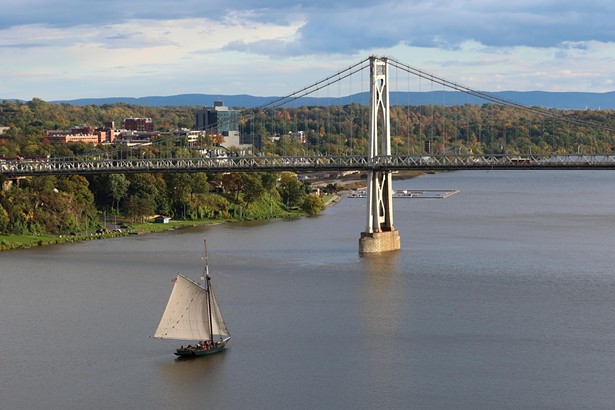The Clearwater has a hell of a large sail; it takes an entire class of fifth graders and a few deck hands to hoist it. The tall mast enables it to catch even the light winds typical of the Hudson River in summertime, so the ship—a replica 18th century Hudson River Sloop—can move smoothly through the water. The advantages of its particular design was what Steve Stanne was thinking about on a sail recently. Despite its majesty, though, Stanne says, “Sloops like Clearwater were essentially the 18-wheelers of the 1800s when the Hudson was New York State’s Thruway. They were the main way you carried freight up and down the river, and their design was unique to the Hudson.”
Stanne has been involved with the Clearwater in various capacities since 1980 when he literally came on board to expand its educational programs. In fact, it was Stanne that a young girl recognized on the street in East Harlem when he was walking with Pete Seeger to a music festival. Seeger was the more famous—a musician, songwriter, and storyteller from 1940s radio and the 1960s folk scene, and the visionary environmental activist who led the build of the Sloop and sailed it to Washington, DC, with thousands of petition signatures to advocate for the passage of the 1972 Clean Water Act. But the girl’s school had just come on the sloop for an educational program with Stanne where they caught a fish inside a tire.
“When I joined the Clearwater and we were sailing in New York Harbor, there were things too fierce to mention floating around in the water; you could really see the impact of raw sewage on the Hudson,” Stanne says. But when they put down the otter trawl–a small scale commercial fishing net—among the trash, they might come up with a blue-clawed crab or a lobster (before they declined with climate change) or a seahorse. “One of the early messages of Clearwater’s education program was just a simple phrase: that river’s alive.”

Since its inception, the Clearwater has educated half a million children aboard its sloop. Each year, 13,000 people go aboard to experience Seeger’s idea: build a tall ship that attracts people to the Hudson, so they can experience its beauty despite the pollution, teach them estuary ecology and sea shanties as they sail, and let them become the river’s advocates. This distinctive brand of doing education on a boat, Stanne points out, has been adopted on numerous vessels around the country and internationally.
But one of Clearwater’s challenges since the beginning of the organization is the cost of maintaining that ship. Sloops in their day may have lasted ten to fifteen years before being decommissioned. Meanwhile, the Clearwater is in its 55th sailing season, and keeping the wooden vessel seaworthy requires expensive winter maintenance and a major project every five to six years. And Clearwater hasn’t developed cash reserves, an investment portfolio, or an endowment the way other fifty-year-old nonprofits do.
Rough Water Ahead
Clearwater had two bad years leading into the pandemic: the last Clearwater Revival, the annual music festival which also served as outreach, membership drive, and fundraiser, lost a significant amount of money in 2019 and hasn’t returned in-person.
During COVID, the Clearwater couldn’t sail with a captain and crew living in the tight deck down below due to pandemic restrictions, and they lost a year and a half of operations.
Last winter their cash inflow was already low as they planned their annual gala, which is both a fundraiser and an opportunity to honor Hudson Valley environmentalists: this year’s Spirit of the Hudson Award went to Dr. Stuart Findlay of the Cary Institute; the Lifetime Contribution Award went to Clearwater’s longtime environmental advocacy director (now retired) and Ulster County Legislator Manna Jo Greene; and a new award for Next Generation Environmental Leadership went to Xiell Owens, an Ecojustice Associate for the Radix Center in the South End of Albany. There was music, of course, and it raised $10,000 more than any gala previously. “But come Monday after the gala, we couldn’t pay our bills,” says Clearwater’s Executive Director David Toman, “and that’s when we knew we’d hit this crisis point for Clearwater, cash-wise.”
In many ways, Toman’s leadership is a leveling up for the organization. Clearwater’s board of directors passed a comprehensive strategic plan in December 2021, which identified Clearwater’s core competencies and value to the community, as well as two main targets: to improve the organization’s professionalism and financial oversight. Toman’s blend of experience with nonprofit finance, strategic planning, and program management was a good match for where the organization was heading, and they brought him on in January 2022.
During the process of catching up on delayed financial reporting, Clearwater temporarily lost its 501c3 status and missed the window to apply for grant funding crucial to operations. Toman and the board immediately reached out to longtime donors with a letter from the Board President inviting them to a Zoom session to discuss the situation.
In May, Clearwater announced a short-term funding crisis and implemented a bridge funding campaign. They set a goal to raise $250,000 to maintain operations, continue their school programming through spring and summer, and begin a business planning project. By early June, Clearwater had surpassed its campaign goal by almost $100,000, raising $347,000 in bridge funding, which will allow them to build a sustainable business model. “Today, I am very optimistic we are here to stay,” Toman says. “The only reason we’re there is because the public is deciding whether we’re important. And, to me, that’s the most incredible story; people have such a deep emotional commitment to us, and we’ve earned that over time.”
Like a lot of people involved with Clearwater, Samantha Hicks has consistently returned to the organization. She’s Board President now, but was once an apprentice on the sloop, then first mate, then captain. The Clearwater boasts appointing the first female captain of a commercial vessel on the Hudson, Cate Cronin, and when Hicks was first apprenticed years ago, at age 22, both the captain and first mate were women. “That's what Clearwater is modeling with the classes on board: that representation,” Hicks says. “There's women in authority, and the kids hoist the sail, and it doesn’t matter what your gender or age is. We're all going to treat everybody respectfully because no one's getting a 3,000-pound sail up alone; everybody needs to work together.”
Clearwater is not only a boat that people have a nice memory of in fifth grade; it’s recognized in the sailing community as a great training ground: volunteer for a week, apprentice for a month or two, get hired to crew, learn the art of wooden ship restoration. Mariners have gone on to sail oceans, captaining vessels, and into the world of ship building. The organization also boasts about people, like Hicks, who have been bitten by the Hudson River and by Clearwater’s mission to inspire its stewardship, and go on to make it their life’s work.
As Board President, Hicks wants to assemble an advisory committee specifically for the bridge funding. “Folks who would come up with ideas that somebody on the inside might not entertain because you’re just so used to what you know, but then who also game out the reality of those ideas,” she says. “What does success look like? Is it getting 500,000 kids out on the river, some of whom didn’t even realize there was a river there?”
An Environmental Icon
Even beyond education, the sloop itself has become an icon of the environmental movement. People see it on the water and know what it represents: cleaning up the Hudson, grassroots activism, hope for the future. From the Clean Water Act to closing Indian Point (and now its decommissioning) to supporting the fracking ban (and now updating it to include a ban on CO2 fracking), Clearwater is also part of the coalition of partners and elected officials advocating to get the country’s largest Superfund site—the remediation of PCBs discharged by General Electric plants into the Hudson 50 years ago—back on track. “Environmental Justice has been core to Clearwater since our founding,” says Jen Benson, Clearwater’s new director of environmental action.
Benson sees the recent outpouring of support from the community through the bridge funding request as a way to continue this work and chart a path forward. “The Hudson River and Hudson Valley need a robust environmental movement to protect the river and communities from legacy and emerging threats,” Benson says, pointing to exacerbating pressures on storm and wastewater infrastructure from climate change, which brings water quality concerns, especially for those communities who get their drinking water from the Hudson. “I'm hopeful Clearwater can build a financially sound future, and continue our education and advocacy efforts for decades to come. ”
Support Clearwater via this link.

















